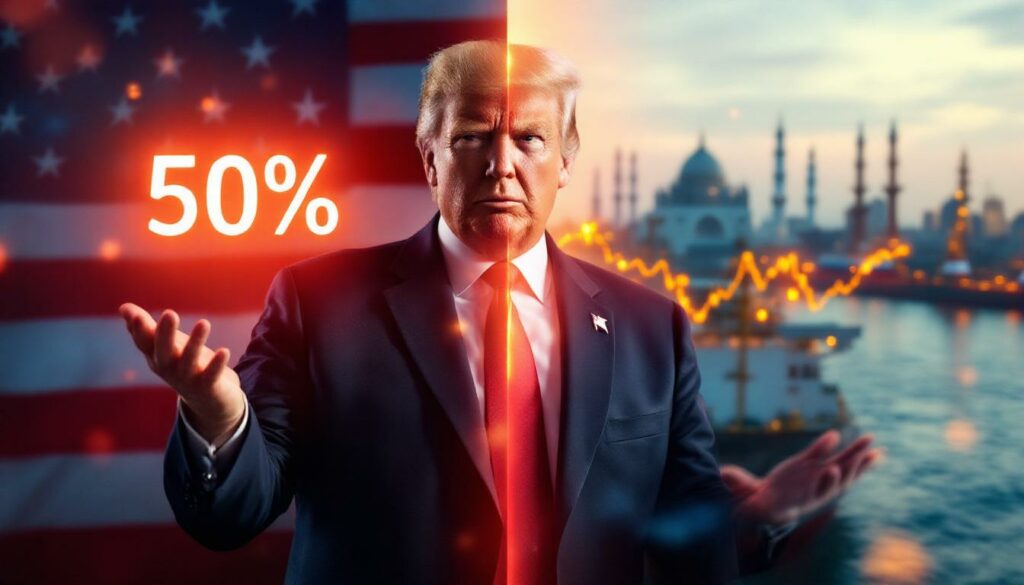Trump's 50% Tariff Threat on Indian Imports: Understanding the Russian Oil Connection
Donald Trump recently proposed imposing substantial 50% tariffs on Indian imports, citing India's continued purchases of Russian oil as justification. This aggressive trade measure represents one of the most significant tariff threats global impact directed at India in recent years, signaling a potential shift in US-India trade relations should Trump return to office.
The proposed 50% tariff would apply broadly to Indian imports entering the United States, affecting billions of dollars in trade. In 2023, the US imported approximately $91 billion worth of goods from India, making such tariffs particularly consequential for both economies.
Why Is Trump Targeting India's Russian Oil Purchases?
Since Russia's invasion of Ukraine in February 2022, India has substantially increased its purchases of Russian crude oil, becoming one of Russia's largest oil customers. India's imports of Russian oil have grown from negligible amounts before 2022 to approximately 1.7-2 million barrels per day in recent months, representing over 40% of India's total oil imports.
Trump's tariff threat appears motivated by concerns that India's oil purchases are undermining Western sanctions against Russia by providing significant revenue to Moscow. While the US has implemented various sanctions targeting Russian energy exports, India has maintained that its purchases do not violate international law and represent pragmatic economic decisions.
"India has been very clear about its position on Russian oil imports – they're making purely commercial decisions based on their national interests and energy security strategy needs," noted an international energy policy expert.
The tariff threat also reflects broader strategic competition concerns, as the US seeks to limit Russia's ability to fund its military operations through energy sales. By targeting India, Trump appears to be signaling that even strategic partners must align with US geopolitical objectives or face economic consequences.
India's Response to the Tariff Threat
Indian officials have consistently defended the country's right to purchase oil from Russia, emphasizing energy security and economic considerations. India requires affordable energy sources to sustain its economic growth, and Russian oil—often sold at discounts of $10-15 per barrel below market rates—has provided significant savings for the Indian economy.
"For a country that imports over 85% of its oil needs, these savings amount to billions of dollars annually," explained an energy market analyst familiar with India's oil purchasing strategy. "The discount on Russian oil has helped India manage inflation and support economic recovery post-pandemic."
India has been performing a careful diplomatic balancing act, maintaining positive relations with both Russia (a traditional defense partner) and the United States (a growing strategic ally). The tariff threat complicates this balance and puts pressure on India to reconsider its approach to Russian energy imports.
While India has not announced specific countermeasures, analysts suggest the country might consider retaliatory tariffs on US goods or accelerate efforts to diversify its export markets if the threat materializes. India previously imposed retaliatory tariffs on US goods in response to steel and aluminum tariffs during Trump's first term.
Economic Impact of Potential Tariffs
The US-India trade relationship has grown significantly in recent years, with bilateral trade in goods and services reaching approximately $191 billion in 2023. India is currently the United States' 9th largest trading partner, while the US ranks as India's largest export market.
A 50% tariff on Indian imports would substantially increase costs for US businesses and consumers who rely on Indian goods, potentially disrupting supply chains across multiple industries. Key imports from India include pharmaceuticals, textiles, machinery, and agricultural products, all of which would face significant price increases.
Several sectors would be particularly vulnerable to disruption:
| Sector | US Imports from India (2023) | Potential Impact of 50% Tariffs |
|---|---|---|
| Pharmaceuticals | $9.5 billion | Higher drug prices, supply disruptions |
| Textiles & Apparel | $8.2 billion | Increased consumer goods prices |
| Machinery | $7.1 billion | Manufacturing cost increases |
| Gems & Jewelry | $6.3 billion | Luxury goods price inflation |
| Agricultural Products | $3.7 billion | Food price increases |
"The pharmaceutical sector is especially vulnerable," notes a trade policy expert. "India supplies approximately 40% of generic drugs to the US market. Imposing such steep tariffs could significantly impact healthcare costs and potentially create drug shortages in certain categories."
Trump's Broader Trade Strategy
Trump's approach to international trade has consistently featured tariffs as a negotiation tool to achieve specific policy objectives. The India tariff threat follows a similar pattern to his approach with China, Mexico, and the European Union during his first term, where substantial tariff threats were used to pressure countries into making concessions.
This approach aligns with Trump's "America First" trade philosophy, which prioritizes perceived US interests over traditional free trade principles. This approach views trade war impacts as inherently problematic and uses tariffs to attempt to rebalance trading relationships.
With the US presidential election approaching, the timing of this tariff announcement may also serve domestic political purposes by appealing to voters concerned about foreign competition and American manufacturing. Trade policy has been a signature issue for Trump throughout his political career.
Geopolitical Implications
The tariff threat introduces significant tension into the US-India strategic partnership, which has been strengthened in recent years through initiatives like the Quad (US, India, Japan, Australia) and increased defense cooperation. Economic disputes could undermine progress in security cooperation at a time when both countries share concerns about China's regional influence.
"The timing is particularly delicate given regional security dynamics in the Indo-Pacific," observes a security policy analyst. "The US has been working to strengthen ties with India as part of its strategy to counter China's influence. This tariff threat could complicate those efforts and potentially push India closer to alternative partners."
If India were to reduce Russian oil purchases in response to US pressure, it would need to find alternative suppliers, potentially driving up global oil prices. This could have ripple effects throughout the global economy, affecting inflation rates and economic growth.
Russia would likely seek alternative markets for its oil if India reduced purchases, potentially offering even steeper discounts to countries willing to defy Western pressure. This could undermine the effectiveness of sanctions and create new geopolitical alignments.
Effects on Global Oil Markets
Russia has been selling oil to India and other buyers at significant discounts compared to international benchmark prices, sometimes exceeding $10-15 per barrel below market rates. These discounts have been necessary to attract buyers willing to navigate the complexities of Western sanctions.
If India were to reduce Russian oil imports, several market scenarios could unfold:
- Price Increases: Global oil prices could rise if India shifts to non-Russian suppliers, increasing competition for other oil sources
- Discount Deepening: Russia might offer even deeper discounts to maintain market share
- Market Redistribution: Oil flows could reorganize, with Russia finding new buyers and India securing new suppliers
The Organization of Petroleum Exporting Countries and its allies (OPEC+) would likely adjust production strategies in response to any major shift in Russian oil flows, potentially limiting production to maintain price stability if market disruptions occur.
A commodities trader with experience in Asian markets explains: "The oil market has already adjusted to the new reality of Russian exports going predominantly to India and China. Any disruption to these flows would require time for the market to rebalance, likely leading to temporary price volatility in global oil dynamics."
India's Alternatives to Russian Oil
If India were to reduce Russian oil imports, it could increase purchases from several alternative sources:
| Supplier | Advantages | Challenges |
|---|---|---|
| Middle East (Saudi Arabia, UAE) | Geographic proximity, established relationships | Higher prices, OPEC+ production constraints |
| United States | Growing production, political alignment | Higher transportation costs, price premium |
| Africa (Nigeria, Angola) | Competitive pricing, quality matches | Political instability, production reliability |
| Latin America (Brazil, Guyana) | Growing production, diversification | Long shipping distances, limited capacity |
Any shift away from discounted Russian oil would likely increase India's import costs significantly. With oil comprising approximately 30% of India's total import bill, higher prices could impact inflation, fiscal balances, and economic growth.
Many Indian refineries are technically optimized to process specific grades of crude oil. Switching suppliers may require technical adjustments and potentially significant investments in refinery modifications.
"India's refining system has adapted to Russian Urals crude, which has similar characteristics to the Middle Eastern grades they traditionally processed," explains a petroleum engineering expert. "But not all crude oils are created equal—different grades have varying sulfur content, API gravity, and other specifications that affect refining efficiency and output."
Historical Precedents for Similar Tariff Actions
During his first term, Trump imposed various tariffs on trading partners:
- 25% tariffs on steel and 10% on aluminum imports from multiple countries
- Escalating tariffs on Chinese goods eventually covering $370 billion in imports
- Threatened 25% tariffs on Mexican imports over immigration concerns
- Tariffs on European goods related to aircraft subsidies
Previous tariff disputes typically resulted in one of three outcomes:
- Negotiated Settlements: As with the USMCA agreement replacing NAFTA
- Retaliatory Tariffs: As seen in the US-China trade war
- Prolonged Trade Tensions: As experienced with the EU over various disputes
Previous tariff actions faced legal challenges both domestically and at the World Trade Organization, with mixed results. Any new tariffs would likely face similar scrutiny.
Impact on India's Energy Security Strategy
India imports approximately 85% of its oil needs, making energy security a critical national priority. Any policy that restricts India's ability to source affordable oil could have significant economic and security implications.
India has been working to diversify its energy sources through:
- Expanding domestic renewable energy capacity
- Developing strategic petroleum reserves
- Investing in overseas oil and gas assets
- Exploring alternative energy technologies
The tariff threat may accelerate India's efforts to reduce oil dependency through faster adoption of electric vehicles, renewable energy, and improved energy efficiency measures.
An energy security analyst notes: "India's current energy transition plan already aims to reduce fossil fuel dependency, but economic realities mean this will take decades, not years. In the interim, securing affordable oil supplies remains essential for India's economic growth and energy security."
Potential Outcomes and Scenarios
Scenario 1: Negotiated Compromise
India and the US could reach a compromise where India gradually reduces Russian oil purchases while the US offers alternative energy arrangements or other trade concessions.
"A pragmatic solution might involve India agreeing to cap Russian oil imports at current levels rather than continuing to increase them," suggests a former trade negotiator. "This would allow India to maintain its economic benefits while addressing US concerns about growing Russian oil revenues."
Scenario 2: Escalation and Retaliation
If tariffs are implemented, India could impose retaliatory measures on US exports, potentially escalating into a broader trade conflict that damages bilateral relations.
Scenario 3: Status Quo Maintenance
India might continue Russian oil purchases despite tariff threats, absorbing the economic costs or finding ways to mitigate them through other trade adjustments.
Scenario 4: Multilateral Resolution
The issue could be addressed through multilateral forums like the G20 or WTO, potentially resulting in a broader agreement on energy security and sanctions policies.
Key Questions About Trump's India Tariff Threat
Would these tariffs violate WTO rules?
Broad tariffs imposed specifically on one country without clear national security justification would likely violate WTO principles of non-discrimination. However, the US could attempt to justify them under national security exceptions, though such justifications have been narrowly interpreted.
How would these tariffs affect US consumers?
American consumers would likely face higher prices for numerous products imported from India, including pharmaceuticals, textiles, and consumer goods. This could contribute to inflationary pressures in the US economy.
"US pharmaceutical companies rely heavily on Indian-made active pharmaceutical ingredients and finished dosage forms," notes a healthcare supply chain expert. "Any disruption or price increases would eventually be passed on to patients and healthcare systems."
Could India completely stop buying Russian oil?
Completely eliminating Russian oil purchases would be challenging for India given the volume involved and the economic advantages of discounted prices. A gradual reduction would be more feasible than an immediate halt.
What industries in India would be most affected?
Export-oriented sectors like textiles, pharmaceuticals, IT services, and manufacturing would face the greatest impact from US tariffs, potentially leading to job losses and economic contraction in these industries.
How might this affect US-India defense cooperation?
Defense cooperation could be collateral damage in a trade dispute, potentially slowing arms sales, joint exercises, and technology sharing at a time when both countries are concerned about China's regional influence.
"The US-India defense relationship has been one of the bright spots in bilateral ties over the past decade," observes a defense policy specialist. "Both countries have strong incentives to insulate this cooperation from trade disputes, but significant economic tensions could eventually spill over into other domains."
A Multifaceted Challenge Requiring Careful Navigation
Trump's tariff threat represents a complex challenge at the intersection of international trade, energy security, and geopolitics. For India, it highlights the delicate balancing act of maintaining energy security while nurturing an increasingly important strategic partnership with the United States.
For the global oil market, any significant shift in India's purchasing patterns could trigger market realignments and price volatility. The situation underscores how energy markets have become increasingly intertwined with geopolitical objectives and national security concerns.
As this situation unfolds, policymakers in both countries will need to weigh economic interests against strategic priorities, seeking solutions that address US concerns about Russian oil revenues while respecting India's legitimate energy security needs.
"The energy transition is happening, but oil remains vital to the global economy. Nations must navigate a complex landscape where tariffs impact markets and energy decisions are simultaneously economic, political, and strategic in nature," concludes an international energy policy expert according to Reuters.
Want to Stay Ahead of Market-Moving Mineral Discoveries?
Discovery Alert's proprietary Discovery IQ model provides real-time notifications when significant ASX mineral discoveries are announced, giving traders and investors a crucial market advantage before news becomes widely known. Explore how historic discoveries have generated exceptional returns by visiting the Discovery Alert discoveries page and position yourself to capitalise on the next major find.




